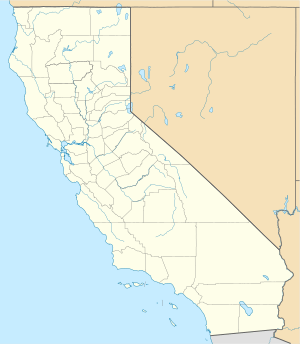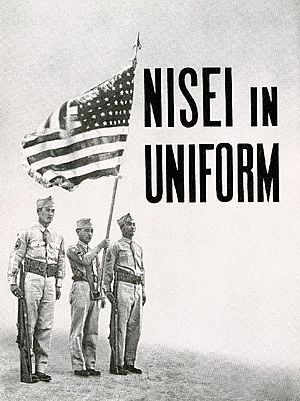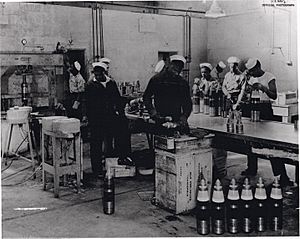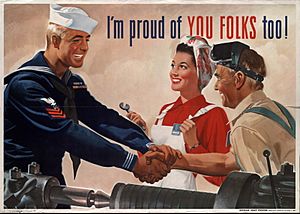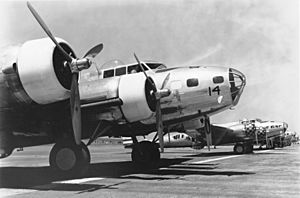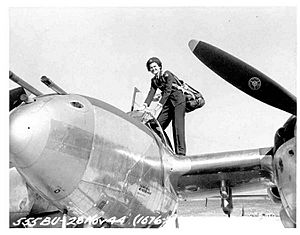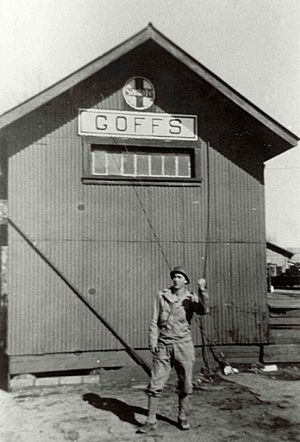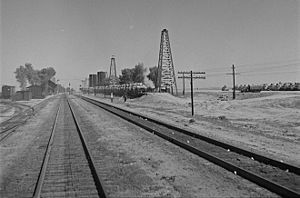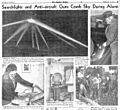California during World War II facts for kids
Quick facts for kids California during World War II |
|
|---|---|
| Location | California, United States |
| Date | 1941–1945 |
| Casualties | 17,022 |
California during World War II played a huge role in the war effort. Its long Pacific Ocean coastline was perfect for supporting the Pacific War. California also helped with the war in Europe. After Japan attacked Pearl Harbor, Hawaii, on December 7, 1941, California's factories quickly switched to making war supplies.
The state became a major builder of ships and aircraft. Existing military bases grew, and many new ones were built. California trained many troops before they went overseas. Over 800,000 Californians served in the U.S. Armed Forces. Farms and ranches in California helped feed soldiers worldwide.
Because of its long coast, people in California worried about attacks. The state was also used for temporary and permanent internment camps for Japanese Americans. California's population grew a lot. This was because many soldiers were stationed there. Also, many workers moved to the state for jobs in the growing defense industries. All this new activity helped California recover from the Great Depression. Over 500,000 people moved to California for these new jobs. The state also increased its oil and mineral production to meet war demands.
Contents
- How did California's economy change during the war?
- Jobs and population boom
- How did California help feed the troops?
- What happened to Japanese Americans during the war?
- Were there attacks on California?
- How did California make ammunition?
- How did Hollywood help the war?
- How did California help pay for the war?
- What was the California National Guard's role?
- What was civil defense like?
- How did railroads help the war?
- What research happened in California?
- How did California help veterans after the war?
- How did California make war supplies?
- What military bases were in California?
- Images for kids
How did California's economy change during the war?
Jobs and population boom
California companies received 12% of all U.S. Government war contracts. About 17% of all war materials were made in California. Industries like mining, natural gas, and oil production grew quickly. They had been active before the war. Mines and mining towns became busy again. This was due to a higher demand for gold, copper, and silver. California's oil production doubled. A new synthetic rubber industry started in California. The state's farm output almost tripled.
In 1941, California produced 230 million barrels of oil. By 1945, this jumped to over 326 million barrels. Raw materials also came to California from U.S. Allies through Lend-Lease. After Pearl Harbor, many new military bases, airfields, and training camps were built. These projects brought tens of thousands of workers to California. Many stayed after the war. Towns and cities near military and industrial sites grew. California's population rose from 6.9 million in 1940 to 10.5 million in 1950. This was a 53.3% increase!
With many men fighting, women joined the workforce. They took jobs in factories and other places. Businesses added more shifts. Stores and services stayed open longer. Some companies offered better employee benefits to keep workers. Many soldiers trained in California returned after the war. This helped California's tourist industry grow.
How did California help feed the troops?
California's mild climate was perfect for growing food all year. With many men overseas, there was a shortage of workers at harvest time. Housewives, students, and Scouts helped with harvesting. Some businesses even loaned workers to help with food processing. The Woman's Land Army of America also helped.
Even with more food being grown, there was mandatory food rationing. People were encouraged to plant Victory gardens. The slogan "grow your own, can your own" meant families should grow and can their own food. California's mild climate meant gardens could grow almost all year. Tires and gasoline were also rationed. Wool fabric was also rationed. This was one reason for the Zoot Suit Riots in Los Angeles in June 1943.
What happened to Japanese Americans during the war?
After the attack on Pearl Harbor, some feared that Japanese Americans might be loyal to Japan. On February 19, 1942, President Franklin D. Roosevelt signed Executive Order 9066. This order allowed the Secretary of War to create military zones. This led to the internment of Japanese Americans. California had some of these prisoner of war camps and internment camps. The War Relocation Authority built temporary and permanent camps.
Japanese Americans had to register and turn in weapons and short-wave radios. They were first sent to temporary camps in California. Examples include the Pomona and Santa Anita assembly centers. From there, many were sent to other states. Some went to California's Manzanar War Relocation Center or the Tule Lake War Relocation Center.
Even with internment, many American-born Japanese (called Nisei) volunteered for the U.S. military. These Nisei units fought bravely and received many awards. They joined all branches, mostly the U.S. Army.
California also housed prisoner of wars (POWs). Camp Haan near March Air Reserve Base held 1,200 Italian and German POWs. In total, 21 POW camps were built in California. Many Italian POWs volunteered to help the U.S. in Italian Service Units. They worked on Army depots, farms, and hospitals. This gave them better housing than regular POW camps. Camp Lamont held German POWs who worked on crops. Camp Cooke also held German POWs.
Were there attacks on California?
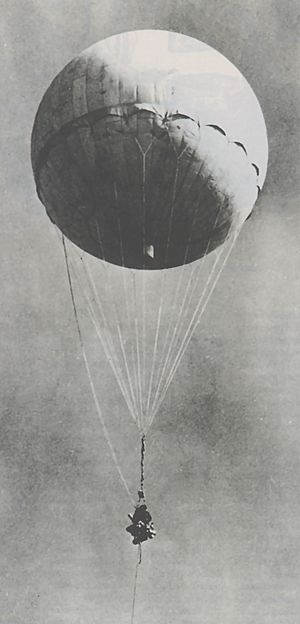
On February 23, 1942, a Japanese submarine, I-17, bombed the Ellwood Oil Field near Goleta, California. It fired 16 shells. This attack, along with the Niihau Incident, made people fear an invasion of California. Many thought the Japanese fleet that attacked Pearl Harbor would come next. This fear also led to the internment of Japanese Americans. There were no deaths in the attack. The damage cost about $1,000. News of the attack caused an invasion scare along the West Coast of the United States.
Another attack involved Fu-Go balloon bombs. Japan launched these fire bomb balloons across the Pacific Ocean. They carried bombs and explosives. In California, 25 balloon bombs were found, but none caused injuries. These balloons were launched from November 1944 to April 1945. On February 23, 1945, a P-38 Lightning plane shot down a balloon near Santa Rosa, California.
Japanese submarines also attacked ships off the California coast. Ships like the SS Emidio and SS Larry Doheny sank. Eight seamen were killed, and others were hurt. After Pearl Harbor, five Japanese submarines attacked ships near California.
Because of the fear, California coastal cities turned off lights at night. Some people put sandbags around their homes. Some radio stations went off the air. Civilian ships were told to stay in port. Commercial air travel was stopped. A military defense system was set up along the coast. This included blimps, patrol ships, artillery batteries, and aircraft.
The great fear led to the Battle of Los Angeles. On February 24 and 25, 1942, Los Angeles thought it was under attack. U.S. anti-aircraft guns fired 1,440 rounds at what turned out to be nothing. Reports of an unknown aircraft caused a blackout and shooting. The only damage was from falling anti-aircraft fire. The event showed how vulnerable the West Coast was. California only had 16 modern warplanes at the time.
After the war, it was learned that a planned attack on San Diego Bay was called off. On December 24, 1941, Japanese submarine I-10 and seven other submarines were supposed to shell the U.S. Navy at San Diego Bay. The attack was canceled when the subs were only 20 miles off the coast.
How did California make ammunition?
California was a big producer of ammunition for the war. Off the coast, ships harvested kelp from large kelp forests. The kelp's nitrate, actin, and potash were used to make gunpowder.
The biggest World War II accident in California was the Port Chicago disaster. The ship SS E. A. Bryan exploded on July 17, 1944. It was being loaded with about 4,600 tons of explosives. The explosion killed 320 sailors and civilians. It also injured 390 others. Another ship, the SS Quinault Victory, was destroyed. A Coast Guard fireboat sank. The port, its buildings, and much of the nearby town were badly damaged.
Riverbank Army Ammunition Plant and Benicia Arsenal were two of the largest ammunition makers. In San Bernardino, the Western Stove Company built incendiary bombs. Three California Victory ships carrying ammunition for troops in the Pacific sank after Kamikaze attacks. These were the SS Canada Victory, SS Logan Victory, and SS Hobbs Victory.
How did Hollywood help the war?
Hollywood continued to make movies during the war. Besides entertainment, Hollywood made training films and films to boost morale. The 1942 film The Arm Behind the Army showed how important support from home was.
Bob Hope volunteered with the United Service Organizations (USO). He entertained troops during World War II and for many years after. Hope brought many Hollywood stars with him on his USO tours.
Desi Arnaz was stationed at Birmingham General Army Hospital in Van Nuys, California. He entertained troops there. Arnaz had a bad knee, so he was transferred to the U.S. Army Medical Corps. He also helped coordinate stars who visited the hospital.
How did California help pay for the war?
To help pay for the war, the U.S. sold war bonds. California's booming economy meant it was one of the top states for selling U.S. War Bonds. Much of the advertising for war bonds was donated. People felt a strong sense of sacrifice to defend democracy. Selling bonds was also a way to honor American troops.
A short film called Hollywood Victory Caravan (1945) promoted bond sales. It featured stars like Bing Crosby, Bob Hope, and Humphrey Bogart. Other heroes like boxer Joe Louis and baseball player Joe DiMaggio also sold war bonds. Albert Einstein even donated his original manuscript on the theory of relativity to be auctioned for war bonds.
What was the California National Guard's role?
The California National Guard was called to active duty in August 1940. The U.S. Army recruited the first group for the war in Europe. Other troops were sent to the Pacific War. Between 1940 and 1941, about 12,000 California National Guard troops were called to federal service. Some defended California and Hawaii. The California National Guard also patrolled the coast. They guarded Army Air Force bases, railroad bridges, tunnels, and dams. Major training bases included Camp Roberts and Camp San Luis Obispo.
What was civil defense like?
After the attacks on Pearl Harbor and California, civil defense systems started in California. The Office of Civilian Defense was created in May 1941. The Civil Air Patrol began in December 1941. Civilian planes and spotters helped with air patrols, search-and-rescue, and transport. The United States Coast Guard Auxiliary also used civilian boats for patrols and rescues.
Towers were built along the California coast. Spotters staffed them to look for enemy aircraft. They worked with the Ground Observer Corps. In February 1942, the government started "War Time," which ended in September 1945. California's time was renamed "Pacific War Time" with special Daylight Savings times.
The Women Airforce Service Pilots (WASP) started in August 1943. These 1,074 civilian women pilots flew new warplanes from factories to Army airfields. They also towed targets for anti-aircraft practice. They simulated attacks and transported cargo. WASP headquarters in California included Santa Ana Army Air Base and Merced Army Airfield.
How did railroads help the war?

American railroads moved 70% of all freight in the U.S. in 1940. During World War II, passenger and freight volume increased greatly. Railroads moved about 90% of the military's cargo and 98% of its personnel. Railroads worked extra hours to keep up. People were encouraged to avoid unnecessary travel. This made space for troop movement.
Railroads brought troops to California training centers. They also brought workers to California's growing defense industry. During the war, rail lines switched from steam locomotives to Diesel locomotives. Diesel engines needed less labor. The Army had special hospital cars built to move wounded soldiers. One operated out of San Francisco. Many cities still had local tram services, like Los Angeles's large Pacific Electric system.
What research happened in California?
Developing new systems was key to winning the war. World War II brought many new technologies. Some California colleges and universities joined the V-12 Navy College Training Program. This trained volunteers for Navy roles. Some universities also taught aeronautical engineering. They had inspectors for naval materials and worked with the National Defense Research Committee.
Key research sites in California included:
- Los Alamos National Laboratory: A top-secret site for the Manhattan Project.
- California Institute of Technology: Focused on aeronautics, wind tunnels, and rocketry.
- University of California, Berkeley: Also involved in the Manhattan Project.
- Stanford University: Did research on radar microwaves.
- University of California-San Diego: Developed Frequency modulation Sonar to track multiple targets.
- University of California, Los Angeles: Participated in the V-12 Navy College and Scuba diving research.
- Early Penicillin experiments were done at the Kaiser Richmond Shipyards.
- Skunk Works: Designed planes and jets.
- Hewlett-Packard: Built oscillators for proximity fuzes and microwave Signal generators used in radar.
- Hollywood actor Hedy Lamarr and George Antheil invented Frequency-hopping spread spectrum for the Navy.
How did California help veterans after the war?
After the war, Operation Magic Carpet brought troops home. Some brought home war brides. On October 30, 1944, Governor Earl Warren started the California Veteran's Commission. This group helped veterans return to civilian life. The Commission worked with the United States Department of Veterans Affairs and other groups. Many Veterans Health Administration facilities opened in the state. The Veteran's Bond Act of 1943 helped veterans buy homes or farms. Veterans started families, leading to the baby boom in the U.S. and California.
How did California make war supplies?
Ship building

California became a major builder of ships for the war. Under the Emergency Shipbuilding Program, cargo ships like Liberty ships and Victory ships were built in days, not months. California shipyards also built floating dry docks. These helped repair ships overseas much faster.
Because of fears of attack, some ships were built at inland ports. Many new ships were built at the Port of Stockton, 70 miles from the ocean. Henry J. Kaiser built day care centers at his shipyards in Richmond. Kaiser Steel was based in Fontana, California. Some ships were given to Allies of World War II through the Lend-Lease act. After the war, there were too many ships. Most shipyards closed. Extra ships were sold or stored in the Navy Reserve Fleet, like the Suisun Bay Reserve Fleet.
Here are some of the shipyards in California:
Los Angeles area
Major shipyards:
- California Shipbuilding Corporation in Wilmington: Built 306 Liberty cargo ships, 101 Victory cargo ships, 30 attack transports, and 30 tankers.
- Consolidated Steel Corporation: Had shipyards in Wilmington and Long Beach. Built 18 frigates, 32 attack transports, and many cargo ships.
- Bethlehem Shipbuilding San Pedro: Built 26 destroyers.
- Todd Pacific Shipyards, Los Angeles Division in San Pedro: Built 10 auxiliary ships.
Minor shipyards:
- Hodgson-Greene-Haldeman in Long Beach: Built wooden tugboats.
- Fellows & Stewart in Wilmington: Built sub chasers and rescue boats.
- Harbor Boatbuilding at Terminal Island: Built minesweepers, torpedo boats, and rescue boats.
- Al Larson Boat Shop in San Pedro: Built minesweepers and sub chasers.
- United Concrete Pipe Corporation in Long Beach: Built ships.
- Peyton Company in Newport Beach: Built sub chasers and harbor tugs.
San Francisco Bay Area
Major shipyards:
- Bethlehem Shipbuilding Union Iron Works in Alameda: Built battleships and tugs. Also 4 cruisers, 36 destroyers, 12 destroyer escorts, and cargo ships.
- Richmond Shipyards (Kaiser):
- No. 1 Yard: Built Oceans, Libertys, and Victorys.
- No. 2 Yard: Built Liberty and Victory ships.
- No. 3 Yard: Built C4-class ships.
- No. 4 Yard: Built Landing Ship, Tanks (LSTs) and tugs.
- Mare Island Naval Shipyard in Vallejo: Built 31 destroyer escorts and 18 submarines.
- Moore Dry Dock Company in Oakland: Built C2 Cargo ships.
- Western Pipe and Steel Company in San Francisco: Built cargo ships.
- Marinship in Sausalito: Built T2 tankers.
Minor shipyards:
- Hunters Point Naval Shipyard: Built Liberty ships.
- Cryer & Sons in Oakland: Built Navy coastal cargo ships.
- Kneass Boat Works in San Francisco: Built sub chasers and tugs.
- Pacific Bridge Company in San Francisco: Built repair docks and cargo ships.
Other California shipyards
- Pollock-Stockton Shipbuilding Company in Stockton: Built net layers and dry docks.
- Eureka Shipbuilding in Fields Landing: Built tugboats.
- Concrete Ship Constructors in National City: Built concrete barges.
- Colberg Boat Works in Stockton: Built minesweepers, tugs, and sub chasers.
- Stephens Bros. Boat Builders in Stockton: Built picket boats, tugs, and rescue boats.
- Campbell Industries in San Diego: Built four minesweepers.
- National Steel and Shipbuilding Company (NASSCO) in San Diego: Built U.S. Army barges.
- Lynch Shipbuilding in San Diego: Built rescue tugs and coastal cargo ships.
- South Coast Shipbuilding in Newport Beach: Built minesweepers, sub chasers, and crash boats.
Aircraft manufacturers
California built many famous planes during World War II. These included the B-17 Flying Fortress, Lockheed P-38 Lightning, Douglas C-47 Skytrain, and P-51 Mustang. The Lockheed Hudson was built in Burbank and sent to Canada and the United Kingdom starting in 1939.
By the end of the war, California produced 70% of all aerospace manufacturing in the U.S. It had built over 200,000 planes. The California Institute of Technology in Pasadena, California started a "School of Aeronautics" in the 1920s. This helped California become a major center for aircraft making.
Here are some of the aircraft manufacturers in California during World War II:
- Douglas Aircraft Company in Santa Monica, El Segundo, Long Beach, and Torrance.
- Lockheed Corporation in Burbank.
- Vega Aircraft Corporation in Burbank.
- Northrop Corporation in Hawthorne.
- Hughes Aircraft Company in Playa Vista and Culver City.
- Consolidated Aircraft in San Diego.
- Ryan Aeronautical in San Diego.
- North American Aviation in Inglewood.
- Vultee Aircraft in Burbank and Downey.
- O.W. Timm Aircraft Company in Van Nuys.
- Skunk Works (design HQ) in Burbank.
Vehicle manufacturers
During World War II, all civilian car manufacturing in California stopped. Factories switched to making military vehicles and parts.
- General Motors South Gate Assembly built Stuart M-5 and M5A1 Light Tanks. They made 500 per month.
- General Motors Oakland Assembly built Pratt & Whitney aircraft engines and munitions.
- Ford Motor Company Assembly Plant in Richmond built 49,399 jeeps. The Ford plant also finished work on tanks and other military vehicles. Ford's Long Beach plant was used as an Air Force Base.
- Chrysler of California in Los Angeles built 12,214 aircraft engines. They also built cabins for B-17s and PV-2 Harpoons.
- Studebaker Pacific Corporation of Los Angeles built engines for B-17s and PV-2 Harpoons.
- Menasco Motors Company in Burbank built landing gear for many aircraft makers.
- Firestone Tire and Rubber Company of Los Angeles built 1,550 turrets for M5 tanks. Firestone also built 3,100 M5 tank tracks.
What military bases were in California?
California's weather, open spaces, railroads, and ocean access made it ideal for training troops. Many new military bases were built. These included United States Army airbases.
Desert Training Center
The Desert Training Center was the largest U.S. Army training area ever. General Patton had many desert camps built in Southern California and Arizona. This was to prepare troops for battles in the North African campaign. The camps were in the Mojave Desert and Sonoran Desert. The open space allowed live-fire training. New equipment and combat methods were tested there. The training area covered 18,000 square miles. It stretched from Pomona, California to almost Phoenix, Arizona. It went from Yuma, Arizona north into southern Nevada.
California Army Divisional Camps
- Camp Clipper and Camp Essex
- Camp Coxcomb
- Camp Granite
- Camp Ibis
- Camp Iron Mountain
- Camp Pilot Knob
- Camp Young (Headquarters)
California Army Depots
- Camp Freda Quartermaster Depot
- Camp Desert Center
- Camp Goffs (Depot and Infantry training)
- Pomona Ordnance Depot
California Army Airfields
Major airfields included Blythe Army Air Base and Thermal Army Airfield. Minor airfields included Camp Coxcomb Army Field and Camp Goffs Army Field.
Desert Training Center California Hospitals Hospitals were set up to care for soldiers. These included Banning General Hospital and Camp Desert Center Hospital.
U.S. Army Bases
Existing Army bases in California were expanded. Many new ones were built. Bases were used for training, deployment, supplies, hospitals, and housing POWs. Some important Army bases were:
- Fort Irwin
- Fort Ord
- Parks Reserve Forces Training Area
- Presidio of Monterey
- Military Ocean Terminal Concord
- Camp Anza
- Fort MacArthur
- Camp Roberts Army Base
- Camp San Luis Obispo
- Stockton Ordnance Depot
- Sierra Army Depot
- Birmingham General Hospital
- Benicia Arsenal
- Presidio of San Francisco
Air bases and airfields
Existing United States Army Air Corps air bases were enlarged. Almost all civilian airports became Army Air training centers. Most civilian flights were canceled. Many new airstrips were built for pilot training. Some key Army Air Corps bases and airfields in California:
- Beale Air Force Base (Camp Beale)
- Muroc Army Airfield (now Edwards Air Force Base)
- March Field
- McClellan Air Force Base
- Fairfield-Suisun Air Force Base (now Travis Air Force Base)
- Camp Cooke (now Vandenberg Air Force Base)
- Long Beach Army Air Field
- Ontario Army Air Field
- San Bernardino Army Air Field
- Van Nuys Army Air Field
- Merced Army Air Field
- Victorville Army Air Field
- Hamilton Army Airfield
- Mather Air Force Base
- Norton Air Force Base
- Santa Ana Army Air Base
- Palm Springs Air Base
- Fresno Air Base
- Stockton Army Airfield
The United States Navy's main bases were in deepwater ports. These included San Diego Bay, Port of Los Angeles, San Francisco Bay, and the Stockton Deepwater Shipping Channel. The U.S. Navy Pacific Fleet used ports, supply depots, and airfields. They trained for aircraft carriers and used blimps to patrol the coast. After the war, many shipyards stored extra ships. Some important Navy bases and stations in California:
- Mare Island Naval Shipyard
- Naval Base San Diego
- Hunters Point Naval Shipyard
- Naval Air Weapons Station China Lake
- Naval Base Ventura County
- Naval Air Station Alameda
- Naval Weapons Station Seal Beach
- Naval Construction Battalion Center Port Hueneme
- Naval Air Station North Island
- Long Beach Naval Shipyard
- Moffett Federal Airfield (Naval Air Station)
- Naval Training Center San Diego
- Rough and Ready Island Naval Supply Depot in Stockton
- Naval Amphibious Base Coronado
- Naval Hospital Oakland
- Concord Naval Weapons Station
U.S. Marine Corps
Camp Pendleton became the main training ground for Marines. They learned skills like using landing craft and amphibious tractors. These skills were used in the island hopping strategy in the Pacific War. Key Marine Corps bases:
- Camp Pendleton
- Marine Corps Air Station Miramar
- Marine Corps Logistics Base Barstow
- Marine Corps Recruit Depot San Diego
- El Toro Marine Corps Air Station
- Tustin Marine Corps Air Station
U.S. Coast Guard
During World War II, the United States Coast Guard worked as part of the Navy. In California, they operated from the 12th Naval District. The Coast Guard used its cutters, patrol boats, bases, and lighthouses. Their main jobs were patrols and search-and-rescue missions. Some Coast Guard bases in California:
- Coast Guard Island in Alameda
- Training Center Petaluma
- Coast Guard Air Station San Diego
- Coast Guard Air Station San Francisco
- Coast Guard Station Golden Gate
United States Merchant Marine
The United States Merchant Marine operated merchant ships from California ports. They supplied goods around the world. Most merchant ships had civilian merchants and U.S. Navy armed guards to operate deck guns. They used many types of ships, especially Liberty ships and Victory ships. The Coast Guard trained Merchant Marine members. Training centers in California included:
- Port Hueneme, California (1941–1942)
- Avalon, California (1942–1945)
- Government Island, California (1938–1943)
Images for kids
-
The USS Wadleigh (DD-689) at Mare Island Naval Shipyard, April 10, 1945.
-
The Pomona Assembly Center, a temporary camp for Japanese Americans.
-
The Santa Anita Assembly Center in 1942, with military police.
-
Victory cargo ships at California Shipbuilding Corporation in Los Angeles.
-
Women working on a bomber at Douglas Aircraft Company, Long Beach, October 1942.
-
A Lockheed P-38 Lightning assembly line at the Lockheed plant, Burbank, California.
-
A B-25 Mitchell bomber production line at the North American Aviation plant, Inglewood, October 1942.
-
Photos from the Los Angeles Times about the Battle of Los Angeles, February 26, 1942.
-
An American WWII-era poster promoting Victory gardens.
-
Hanging an engine on a BT-13 Valiant trainer at the Vultee aircraft plant, Downey, California.
-
Florene Watson preparing a P-51D-5NA for a ferry flight from a factory at Inglewood, California.


